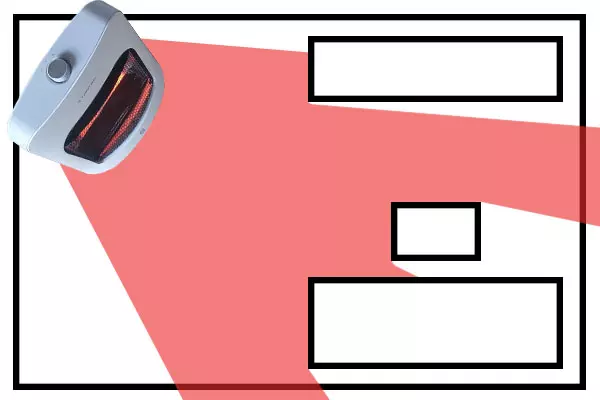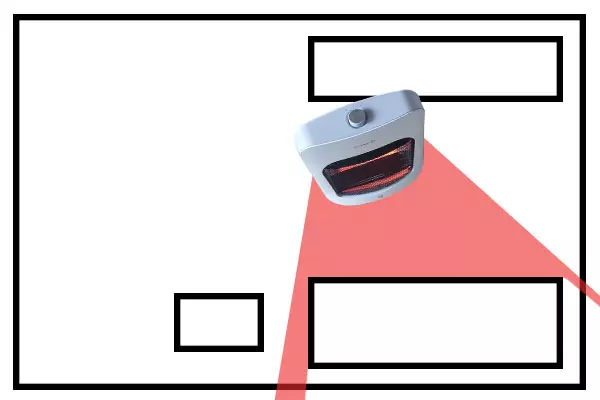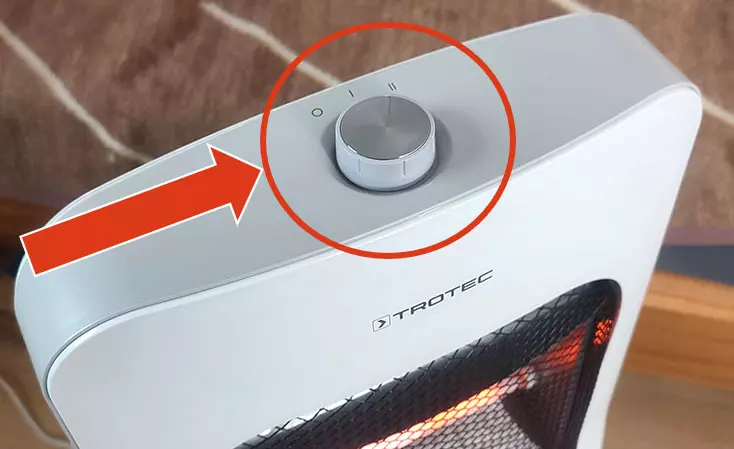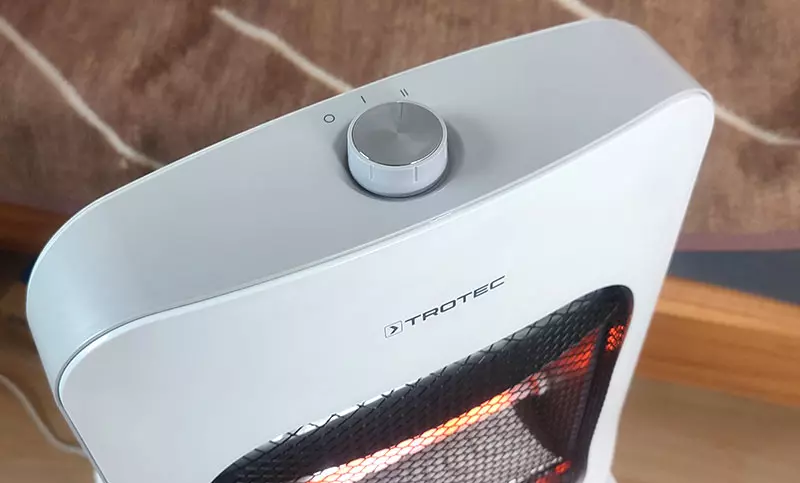Increasing the efficiency of an infrared heater is easy, and you don’t have to be a technician to do so.
In this article, I will give you some tips for increasing infrared heater efficiency and reducing energy costs.
Quick Answer: You can increase your infrared heater’s perceived efficiency by adequately insulating your room (windows, cracks, and gaps below the door). Also, place your infrared heater facing into the room, or facing directly toward people. The technical efficiency of infrared heaters is always 100% since all electric energy ends as heat.
Also buy an infrared heater that fits your room’s size. Preferably, get a powerful model with a built-in thermostat. This way, the heater adapts itself to the room.
Also, keep your space heater at a comfortable temperature.
Can you make infrared heat more efficient?
Before getting into this article, let me describe three different types of efficiencies.
Technical efficiency - How much power does your heater consume and release?
Perceived efficiency - How much heat do you actually get from your heater?
Cost efficiency - How much heat do you get for your money’s worth (return on investment)?
If we talk about technical efficiency, electric resistance heaters are always 100% efficient, as input power (electrical) always equals output power (heat).
So, the technical efficiency is already ideal, and it’s impossible to improve it further.
If we talk about cost-efficiency and perceived efficiency, you can make an infrared heater more efficient.
You have to adjust your room’s insulation, temperature settings, and placement of your infrared heater.
Here’s how:
Improve infrared heater efficiency through proper placement
Placement is everything when it comes to improving your infrared heater’s perceived efficiency.
“The closer your infrared heater is to you, the less power it will have to consume to keep you warm”
You can either set your infrared heater to heat the entire room (for an even heat distribution), or you can place it close to you (to heat only you - for a very high perceived efficiency).
Place the heater in a corner facing your room
Infrared heaters increase the temperature of an area through infrared (heat) radiation. The radiation hits objects or people in your room and causes them to heat up.
For a maximum radiation spread, place your infrared heater in a corner and face into the room.
This way the heat distributes itself evenly within the room.

Place the heater facing the people in your room
The closer you get to an infrared heater, the more heat you perceive.
So, just by moving closer to a heater, you will feel warmer without actually increasing the temperature settings of the heater.
You could also move the heater closer to you and reduce the temperature setting accordingly. This way you save money and energy while still feeling the same amount of heat.
This increases the perceived efficiency of your heater.

Place your heater facing away from (large) windows
Obviously, you should never run an infrared heater facing toward a wide-open window.
The part of the radiation reaching the window is wasted.
But what if you place your infrared heater in a way that it faces a closed window? This could, for example, be the case when you face it toward yourself, but there’s a large window behind you.
The answer is that glass blocks and reflects infrared radiation. It lets visible light pass, but not infrared.
However, from a physicist’s (or engineer’s) point of view, glass lets a distribution of wavelengths pass. The classic mathematical distributions assign values ≠0 to any input number.
So, I’d assume that glass does not reflect infrared radiation perfectly. A fraction of infrared will leave through the window.
And that’s why you should avoid windows (even though they are not the heat sinks one could expect them to be).
Improve infrared cost-efficiency through insulation
Insulation will help you increase the efficiency of your space heater. While the heat your infrared heater produces is constant, the amount of heat leaving your room reduces.
That’s why insulation improves your infrared heater’s cost-efficiency.
Here’s what you can do:
Close the doors and windows
Before turning your infrared heater on, close all the doors and windows of your room, as it will help you lock the heat inside and won’t let the cold enter.
When the doors and windows are open, the space will become larger for the heater to heat, and it consumes more energy.
So, if you want your infrared heater to heat efficiently, close the doors!
Insulate all gaps
If there are gaps in your room window, walls, and doors, heat will leave, allowing the outside air to sneak into your room.
Therefore, blocking the gaps below the door, cracks, or any other space through which your heat radiation can escape is essential.
You can use thermal curtains, bubble wraps, insulated glass units, fiberglass, spray foam, and foam tape to seal windows and cracks.
Also, you can use heavy fabric to block the below-door area, but it is a temporary solution.
I recommend using an under-door drafts stopper. It is made of rubber, and you won’t have to remove it repeatedly as it is comfortable.
Increase cost-efficiency by reducing power consumption
If you want to reduce the power cost and increase the efficiency of your infrared heater, the easiest thing you can do is to set your heater settings at a moderate temperature and place it closer to you.
Setting your infrared heater at a high temperature will keep it running and consume more power to retain that temperature.
Set your infrared heater at a comfortable temperature facing towards you. It will still heat you well enough.

Choose the right infrared heater size
A small heater in a large space will take more time and consume more energy to warm up the whole room.
Small heaters will consume power continuously without actually making you feel any warmer.
Larger heaters with built-in thermostats will heat, and then cut off the heating when the desired temperature is reached.
So, you can’t really pick a too-large infrared heater. You can only pick too small heaters.
Is your thermostat working fine?
If your thermostat device is not working correctly, it is not be able to instruct your infrared heater when to start heating.
You can quick-check your thermostat by running your space heater in a very small room (such as a storage room).
Turn your infrared heater on with full power and see if it turns off on its own after some time.
If it doesn’t turn off within a few minutes and it completely overheats the small room, then likely your thermostat has an issue.
This will cause your infrared heater to overconsume energy when you run it in your living room or bedroom as well.
In this case, I would recommend getting a new heater.
What if your infrared heater is still not heating efficiently?
If, after trying every single efficiency improvement idea in this article your infrared heater is not heating well, there could be an issue with your infrared heater itself.
My favorite one is the Dr. Infrared Heater Dr-968 (click to see my review) .
Are infrared heaters more efficient than regular heaters?
Yes, infrared heaters are more efficient than regular space heaters. It’s because of its working principle, as it emits infrared radiation to warm the object.
Infrared radiation is directional and heats people and objects directly.
That’s what makes infrared heaters more efficient than other types of space heaters.
The only prerequisite is that you use your infrared heater correctly.
I hope the tips in this article helped you improve your infrared heater’s heating capabilities!
I’d say insulation and placement make the biggest efficiency difference!
